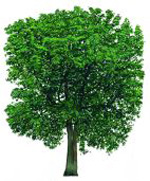Don’t destroy the ash tree
Let natural selection take its natural course, says Mark Griffiths, this could be an opportunity for the ash treeswhich survive


If you want to buy any of the plants mentioned below for your own
garden, visit www.countrylife.co.uk/nursery and type or copy and paste
the name into the search. Plants are delivered in sturdy boxes in a
matter of days from one of the finest nurseries in the country.
An ashplant, says my dictionary, is both a sapling of Fraxinus and a stick made from same, sturdy but pliable and whip-like. It's the latter that they need in Whitehall. According to a recent statement, the Horticultural Trades Association mentioned concerns about ash dieback to the Government as long ago as 2009.
The mouthpiece of the UK garden industry says it was informed that ‘no quarantine action could be taken because the disease was already present and widespread in Great Britain'.
As it turns out, plant-import controls were, and are, futile: wind-borne, this pathogen's spores don't need Continental saplings to ferry them across the Channel. And the disease, we now suspect, may have been in Britain for an age, latent or undiagnosed, mutating or awaiting its moment. But we might ask if Defra was conscious of the threat three years ago, and, if so, why all the panic and unpreparedness this year?
Exquisite houses, the beauty of Nature, and how to get the most from your life, straight to your inbox.
In UK nurseries alone, millions of ash trees will be destroyed, but not by the disease Chalara fraxinea. Many of them are healthy, but have been rendered unsaleable by an official response to epidemics, from foot-and-mouth to Phytophthora, which never seems to vary: ‘slash and burn it, sick or fit'.
This policy was proved to be a disaster decades ago when Dutch elm disease struck. Some elms showed greater resistance than others, and yet almost all were condemned. A gene pool full of recuperative potential was mistaken for so much dirty bathwater. With it, we threw out babies that would have secured our arboreal heritage.
The right response is to let things take their course, to wait and see. With ash, the waiting would be short and the results rapidly visible. It's the fastest-growing, freest-seeding and most adaptable of our native deciduous trees. Many specimens will come to an accommodation with this disease, some will be immune-but not if we've felled and burned them first.
Some pathologists believe that ash dieback may be curable at a local or individual level, and they're already working on treatments. Presented with this news, officials go into jobsworth mode: ‘We'll have to await the outcome of long-term trials, and then there's the licensing process and environmental-impact assessments to consider, and, of course, our colleagues in Brussels.' Meanwhile, we're advised to keep on burning trees, putting muddy kids and dogs through the carwash and sterilising wellies.
In fact, ash dieback is a remarkable opportunity for British science and technology. It ought to galvanise research into chemical controls, plant-breeding and forestry. If the Government isn't prepared to subsidise this work, it must enable private investors to do so.
The aim should be to treat important cases (historic specimens, prized ornamentals) and reservoirs of young trees (nursery stock, some plantations) that are in isolated and thus relatively controllable loc-ations. Various delivery methods look promising. Fogging, for example, which fills the tree's canopy with a chemical cloud, is now proving successful with fungicides on orchards in the Americas. Its size is no reason for not treating a treasured but afflicted tree in exactly the same way as a rose bush.
As for cost, a 1,000-year-old English ash is worth any number of million-pound pandas. Let's con- serve our own heritage for once. But we need to do the research fast, to implement its results regardless of expense and to forget all distaste about chemicals: this disease will not be cured by the horticultural equivalent of alternative medicine. Anyway, if you lose the ash, you lose its ecosystem, and that wouldn't be very Green, would it?
While we let natural selection take its grim course and cheer on the pathologists in their search for a cure, we mustn't lose faith in Fraxinus. I hear prognostications about the ascendancy of Sorbus (no substitute) or even of Eucalyptus (please, God, no). But in terms of ecological role, rapidity of growth, beauty and timber quality, Fraxinus, the ash, is unique and cannot be replaced in our countryside, commercial forestry, gardens and culture. Enough counsels of despair it's time to look for the phoenix in the ashes.
* Subscribe to Country Life and get our Ipad edition at no extra cost
Country Life is unlike any other magazine: the only glossy weekly on the newsstand and the only magazine that has been guest-edited by His Majesty The King not once, but twice. It is a celebration of modern rural life and all its diverse joys and pleasures — that was first published in Queen Victoria's Diamond Jubilee year. Our eclectic mixture of witty and informative content — from the most up-to-date property news and commentary and a coveted glimpse inside some of the UK's best houses and gardens, to gardening, the arts and interior design, written by experts in their field — still cannot be found in print or online, anywhere else.
